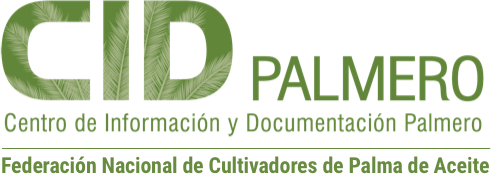| dc.creator | González D., Alexis | |
| dc.creator | García Núñez, Jesús A. | |
| dc.creator | Cortés B., Ingrid L. | |
| dc.creator | Díaz O., Jenifer S. | |
| dc.creator | Dueñas S., Javier | |
| dc.date | 2022-08-01 | |
| dc.identifier | https://publicaciones.fedepalma.org/index.php/palmas/article/view/13711 | |
| dc.identifier | 10.56866/01212923.13711 | |
| dc.description | The different species of fatty acids that comprise the molecular structures of the triglycerides in palm oil, at different conjugation levels that vary among cultivars (D×P and O×G), turn out to be chemical indicators clo- sely related to the iodine value, a quality parameter that determines the degree of unsaturations or the average number of double bonds in oils and fats, with values that can exceed 60 units in fatty compounds with a high content of monounsaturated and polyunsaturated fatty acids. In this study, blends were formed between crude palm oil extracted from tenera D×P type palm cultivars of Elaeis guineensis Jacq. and from four cultivars of O×G interspecific hybrids, at different compositional levels (0, 20, 40, 60, 80 and 100 % m/m-CPO O×G). The lipid profile of pure oils and mixtures generated under controlled laboratory conditions was established by gas chromatography with flame ionization detector, while the iodine value was calculated stoichiometrically from chromatograms obtained. The results were analyzed to determine the possible relationship between the iodine value and the chemical compositional variations in the lipid profile achieved in the CPO with the mixtures, by means of simple linear regressions. From the results, three linear regression models were obtained for the mixtures between: CPO O×G Manaos × Compacta and CPO D×P; between CPO O×G Coari × Super Tenera and CPO D×P; and between CPO O×G Coari × La Mé and CPO D×P, with coefficients of determination (R²) of 0.9852, 0.9845 and 0.9871, respectively. | en-US |
| dc.description | Las diferentes especies de ácidos grasos que conforman las estructuras moleculares de los triglicéridos en el aceite de palma, en diferentes niveles de conjugaciones que varían entre cultivares dura x pisifera (D×P) y oleifera x guineensis (O×G) resultan ser indicadores químicos estrecha- mente relacionados con el índice de yodo, un parámetro de calidad que determina el grado de insaturaciones o el número promedio de dobles enlaces en aceites y grasas, con valores que pueden superar las 60 unidades en compuestos grasos ricos en ácidos grasos mono y poliinsa- turados. En este estudio se conformaron mezclas entre aceite de palma crudo extraído de los cultivares de palma tipo tenera D×P de Elaeis guineensis Jacq. y de cuatro cultivares de híbridos interespecíficos O×G, en diferentes niveles composicionales (0, 20, 40, 60, 80 y 100 % m/m-APC O×G). El perfil lipídico de los aceites puros y de las mezclas generadas bajo condiciones controladas de laboratorio fue establecido mediante cromatografía de gases con detector de ionización de llama, mientras que el índice de yodo fue calculado estequiométricamente a partir de los cromatogramas conseguidos. Los resultados fueron analizados para determi- nar la posible relación entre el índice de yodo y las variaciones químicas composicionales en el perfil lipídico logradas en el aceite de palma crudo (APC) con las mezclas, mediante regresiones lineales simples. De los resultados se destaca la obtención de 3 modelos de regresión lineal para las mezclas entre APC O×G Manaos × Compacta y APC D×P; entre APC O×G Coari × Super tenera y APC D×P; y entre APC O×G Coari × La Mé y APC D×P, con coeficientes de determinación (R²) de 0,9852; 0,9845 y de 0,9871, correspondientemente. | es-ES |
| dc.format | application/pdf | |
| dc.format | text/xml | |
| dc.language | spa | |
| dc.publisher | Fedepalma | es-ES |
| dc.relation | https://publicaciones.fedepalma.org/index.php/palmas/article/view/13711/13554 | |
| dc.relation | https://publicaciones.fedepalma.org/index.php/palmas/article/view/13711/13634 | |
| dc.relation | /*ref*/Adewale, P., Mba, O., Dumont, M. J., Ngadi, M. & Cocciardi, R. (2014). Determination of the Iodine Value and the Free Fatty Acid Content of Waste Animal Fat Blends Using FT-NIR. Vibrational Spectroscopy, 72, 72-78. doi: https://doi.org/10.1016/j.vibspec.2014.02.016 | |
| dc.relation | /*ref*/Advanced Chemistry Development Inc. (ACD/Labs). (2018). ACD/ChemSketch (2018.1). | |
| dc.relation | /*ref*/Almeida, R. F., Santos, I. R., Meira, F. S., Grynberg, P., Lopes, R., da Cunha, R. N. V., Franco, O. L., Scherwinski-Pereira, J. E. & Mehta, A. (2019). Differential Protein Profiles in Interspecific Hybrids Between Elaeis oleifera and E. guineensis with Contrasting Responses to Somatic Embryogenesis Competence Acquisition. Plant Cell, Tissue and Organ Culture, 137(1), 11-21. doi: https://doi.org/10.1007/s11240-018-01545-8 | |
| dc.relation | /*ref*/AOCS. (2010). Official Methods and Recommended Practices of the AOCS (D. F. Mehlenbacher, E. M. Sallee, T. H. Hopper, W. E. Link, R. O. Walker, Ed.; 6th ed.). | |
| dc.relation | /*ref*/Astorkia, M., Hernández, M., Bocs, S., de Armentia, E. L., Herrán, A., Ponce, K., León, O., Morales, S., Quezada, N., Orellana, F., Wendra, F., Sembiring, Z., Asmono, D. & Ritter, E. (2019). Association Mapping Between Candidate Gene SNP and Production and Oil Quality Traits in Interspecific Oil Palm Hybrids. Plants, 8(10). doi: https://doi.org/10.3390/plants8100377 | |
| dc.relation | /*ref*/Azzi, A. (2019). Tocopherols, Tocotrienols and Tocomonoenols: Many Similar Molecules But Only One Vitamin E. Redox Biology, 26, Elsevier B. V. doi: https://doi.org/10.1016/j.redox.2019.101259 | |
| dc.relation | /*ref*/Cadena, T., Prada, F., Perea, A. & Romero, H. M. (2013). Lipase Activity, Mesocarp Oil Content, and Iodine Value in Oil Palm Fruits of Elaeis guineensis, Elaeis oleifera, and the Interspecific Hybrid O×G (E. oleifera × E. guineensis). Journal of the Science of Food and Agriculture, 93(3), 674-680. doi: https://doi.org/10.1002/jsfa.5940 | |
| dc.relation | /*ref*/Chang, S. W. & Lee, H. C. (2019). Vitamin D and Health-The Missing Vitamin in Humans. | |
| dc.relation | /*ref*/Pediatrics and Neonatology (Vol. 60, Issue 3, pp. 237-244). Elsevier (Singapore) Pte Ltd. doi: https://doi.org/10.1016/j.pedneo.2019.04.007 | |
| dc.relation | /*ref*/Chin Soh, A., Mayes, S., Barcelos, E., Amblard, P., Alvarado, A., Alvarado, J. H., Escobar, R., Sritharan, K., Subramaniam, M. & Arulandoo, X. (2017). Elaeis oleifera × Elaeis guineensis Interspecific Hybrid Improvement. En Oil Palm Breeding (1 st, pp. 283-297). CRC Press. | |
| dc.relation | /*ref*/Corredor, A., Martínez, G. & Carreño, Á. (2008). Problemática de la Pudrición del cogollo en Tumaco e instrumentos para su manejo y la renovación del cultivo. Palmas, 29, 11-16. | |
| dc.relation | /*ref*/De Almeida, E. S., da Silva Damaceno, D., Carvalho, L., Victor, P. A., dos Passos, R. M., de Almeida Pontes, P. V., Cunha-Filho, M., Sampaio, K. A. & Monteiro, S. (2021). Thermal and Physical Properties of Crude Palm Oil with Higher Oleic Content. Applied Sciences (Switzerland), 11(15). doi: https://doi.org/10.3390/app11157094 | |
| dc.relation | /*ref*/Dos Santos, L. K., Hatanaka, R. R., de Oliveira, J. E. & Flumignan, D. L. (2019). Production of Biodiesel From Crude Palm Oil by a Sequential Hydrolysis/Esterification Process Using Subcritical Water. Renewable Energy, 130, 633-640. doi: https://doi.org/10.1016/j.renene.2018.06.102 | |
| dc.relation | /*ref*/FAO/WHO. (2013). Norma para los Aceites de Oliva y Aceites de Orujo de Oliva-Codex Stan 33-1981. | |
| dc.relation | /*ref*/FAO/WHO. (2019). Draft Revision to the Standard for Named Vegetable Oils (Cxs 210-1999): Addition of Palm Oil With High Oleic Acid (Oxg). (Issue March). | |
| dc.relation | /*ref*/González-Díaz, A., García-Núñez, J. A. & Dueñas-Solarte, J. (2019). Índice de yodo: un parámetro determinante para establecer el nivel de mezcla entre aceites de palma crudos (APC) provenientes de cultivares DxP e híbridos OxG-“CxL” (N°. 0123-8353 Índice). Ceniavances, 192. | |
| dc.relation | /*ref*/González-Díaz, A., Urrego, N. F., Díaz-Ayala, I. M., García-Núñez, J. A. & Romero, H. M. (2020). Ácidos grasos mono y poliinsaturados: responsables de la variación en el valor del índice de yodo ( IY ) entre aceites de palma crudos procedentes de diferentes cultivares de híbridos OxG. Fedepalma. Recuperado de https://web.fedepalma.org/sites/default/files/files/Cenipalma/Reunion-tecnica-2020/21Acidos%20grasos%20en%20la%20variaci%C3%B3n%20del%20indice%20de%20yodo%20en%20aceite%20de%20palma.pdf | |
| dc.relation | /*ref*/Haaker, M. W., Vaandrager, A. B. & Helms, J. B. (2020). Retinoids in Health and Disease: A Role for Hepatic Stellate Cells in Affecting Retinoid Levels. Biochimica et Biophysica Acta- Molecular and Cell Biology of Lipids (Vol. 1865, Issue 6). Elsevier B. V. doi: https://doi.org/10.1016/j.bbalip.2020.158674 | |
| dc.relation | /*ref*/Israelachvili, J. N. (1974). The Nature of Van Der Waals Forces. Contemporary Physics, 15(2), 159-178. doi: https://doi.org/10.1080/00107517408210785 | |
| dc.relation | /*ref*/Ivanova, D., Zhelev, Z., Getsov, P., Nikolova, B., Aoki, I., Higashi, T. & Bakalova, R. (2018). Vitamin K: Redox-Modulation, Prevention of Mitochondrial Dysfunction and Anticancer Effect. Redox Biology, 16, 52-358). Elsevier B. V. doi: https://doi.org/10.1016/j.redox.2018.03.013 | |
| dc.relation | /*ref*/Kaneko, F. & Yanotj, J. (1998). Diversity in the Fatty-Acid Conformation and Chain Packing of Cis-Unsaturated Lipids. Current Opinion in Structural Biology, 8(4), 417-428. doi: https:// doi.org/https://doi.org/10.1016/S0959-440X(98)80117-6 | |
| dc.relation | /*ref*/Lam, H. Y., Roy, P. K. & Chattopadhyay, S. (2020). Thermal Degradation in Edible Oils by Surface Enhanced Raman Spectroscopy Calibrated with Lodine Values. Vibrational Spectroscopy, 106(October 2019), 103018. doi: https://doi.org/10.1016/j.vibspec.2019.103018 | |
| dc.relation | /*ref*/Lupi, F. R., Greco, V., Baldino, N., de Cindio, B., Fischer, P. & Gabriele, D. (2016). The Effects of Intermolecular Interactions on the Physical Properties of Organogels in Edible Oils. Journal of Colloid and Interface Science, 483, 154-164. doi: https://doi.org/10.1016/j.jcis.2016.08.009 | |
| dc.relation | /*ref*/Mcdonald, J. H. (2009). Handbook of Biological Statistics (2da ed.). Sparky House Publishing. Recuperado de http://udel.edu/~mcdonald/statpermissions.html | |
| dc.relation | /*ref*/Meléndez, M. R. & Ponce, W. P. (2016). Pollination in the Oil Palms Elaeis guineensis, E. oleifera and their Hybrids (OxG), in Tropical America. Pesquisa Agropecuária Tropical, 46(1), 102-110. doi: https://doi.org/10.1590/1983-40632016v4638196 | |
| dc.relation | /*ref*/Ministerio de Salud y Protección Social. (2012). Resolución 2154 de 2012 (p. 32). | |
| dc.relation | /*ref*/Morcillo, F., Vaissayre, V., Serret, J., Avallone, S., Domonhédo, H., Jacob, F. & Dussert, S. (2021). Natural Diversity in the Carotene, Tocochromanol and Fatty Acid Composition of Crude Palm Oil. Food Chemistry, 365. doi: https://doi.org/10.1016/j.foodchem.2021.130638 | |
| dc.relation | /*ref*/Mulia, K., Adam, D., Zahrina, I. & Krisanti, E. A. (2018). Green Extraction of Palmitic Acid from Palm Oil Using Betaine-Based Natural Deep Eutectic Solvents. International Journal of Technology, 9(2), 335-344. doi: https://doi.org/10.14716/ijtech.v9i2.1008 | |
| dc.relation | /*ref*/National Center for Biotechnology Information. (2022a). PubChem Compound Summary for CID 985, Palmitic acid. Retrieved February 1, 2022. Recuperado de https://pubchem.ncbi.nlm.nih.gov/compound/985 | |
| dc.relation | /*ref*/National Center for Biotechnology Information. (2022b). PubChem Compound Summary for CID 445639, Oleic acid. Retrieved February 1, 2022. Recuperado de https://pubchem.ncbi.nlm.nih.gov/compound/Oleic-acid | |
| dc.relation | /*ref*/National Center for Biotechnology Information. (2022c). PubChem Compound Summary for CID 5280450, Linoleic acid. Retrieved February 1, 2022. Recuperado de https://pubchem.ncbi.nlm.nih.gov/compound/5280450 | |
| dc.relation | /*ref*/Osorio-Guarín, J. A., Garzón-Martínez, G. A., Delgadillo-Durán, P., Bastidas, S., Moreno, L. P., Enciso-Rodríguez, F. E., Cornejo, O. E. & Barrero, L. S. (2019). Genome-Wide Association Study (GWAS) for Morphological and Yield-Related Traits in an Oil Palm Hybrid (Elaeis oleifera x Elaeis guineensis) population. BMC Plant Biology, 19(1), 1-11. doi: https://doi.org/10.1186/s12870-019-2153-8 | |
| dc.relation | /*ref*/Tan, C. H., Lee, C. J., Tan, S. N., Poon, D. T. S., Chong, C. Y. E. & Pui, L. P. (2021). Red Palm Oil: A Review on Processing, Health Benefits and its Application in Food. Journal of Oleo Science, 70 (9), 1201-1210). Japan Oil Chemists Society. doi: https://doi.org/10.5650/jos.ess21108 | |
| dc.relation | /*ref*/Torres, G. A., Sarria, G. A., Martínez, G., Varón, F., Drenth, A. & Guest, D. I. (2016). Bud Rot Caused by Phytophthora palmivora : A Destructive Emerging Disease of Oil Palm. Phytopathology, 106(4), 320-329. doi: https://doi.org/10.1094/PHYTO-09-15-0243-RVW | |
| dc.relation | /*ref*/Urrego-M., N. F., Ayala, I. M. & Romero, H. M. (2019). Variación en la composición de ácidos grasos en cultivares híbridos entre Elaeis oleifera x Elaeis guineensis ( OxG ) sembrados en Colombia. | |
| dc.relation | /*ref*/USDA-FAS. (2021, April 5). Palm Oil Explorer. Recuperado de https://ipad.fas.usda.gov/cropexplorer/cropview/commodityView.aspx?cropid=4243000&sel_year=2020&rankby=Production | |
| dc.relation | /*ref*/Wood, J. D., Enser, M., Richardson, R. I. & Whittington, F. M. (2007). Fatty Acids in Meat and Meat Products. Fatty Acids in Foods and their Health Implications, Third Edition (pp. 87-107). CRC Press. doi: https://doi.org/10.1201/9781420006902.ch5 | |
| dc.rights | Derechos de autor 2022 Revista Palmas | es-ES |
| dc.rights | https://creativecommons.org/licenses/by-nc-nd/4.0 | es-ES |
| dc.source | Palmas; Vol. 43 Núm. 2 (2022); 29-36 | es-ES |
| dc.source | 2744-8266 | |
| dc.source | 0121-2923 | |
| dc.subject | Crude palm oil | en-US |
| dc.subject | Interspecific oil palm hybrids | en-US |
| dc.subject | Elaeis oleifera | en-US |
| dc.subject | Unsaturated fatty acids | en-US |
| dc.subject | Fatty acid profile | en-US |
| dc.subject | Aceite de palma crudo; | es-ES |
| dc.subject | Híbridos interespecíficos de palma aceitera | es-ES |
| dc.subject | Elaeis oleifera | es-ES |
| dc.subject | Ácidos grasos insaturados | es-ES |
| dc.subject | Perfil de ácidos grasos | es-ES |
| dc.title | Compositional indicators in palm oil fatty acid chemistry. How relevant is the iodine value? Iodine value ‒ A structural indicator of the purity of crude palm oil from D×P and O×G cultivars | en-US |
| dc.title | Indicadores composicionales en la química de los ácidos grasos en el aceite de palma. ¿Qué tan relevante es el índice de yodo? Iodine value ‒ A structural indicator of the purity of crude palm oil from D×P and O×G cultivars | es-ES |
| dc.type | info:eu-repo/semantics/article | |
| dc.type | info:eu-repo/semantics/publishedVersion | |


